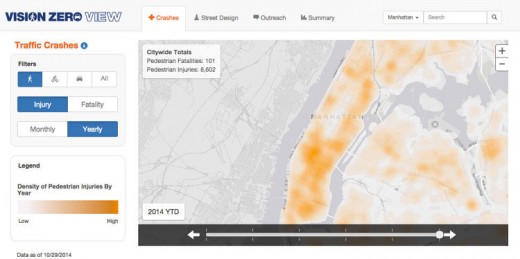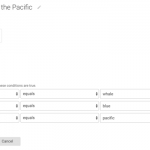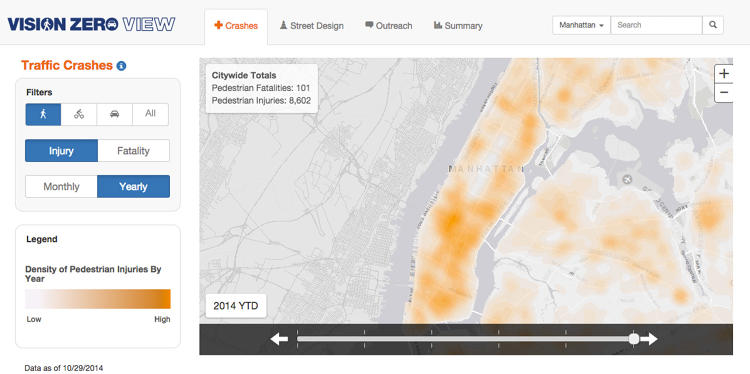the most bad Streets In NYC For Pedestrians
Plus, what NYC is doing to make streets safer.
Editor: Suzanne LaBarre
NY city Transportation Commissioner Polly Trottenberg announced a brand new interactive part of town’s imaginative and prescient Zero site at a symposium on traffic security in Brooklyn Friday morning. imaginative and prescient Zero, an idea pioneered in Sweden and adopted previous this yr as New York city coverage, is all about redesigning streets and visitors patterns with the intention of reducing visitors fatalities to zero.
At a imaginative and prescient Zero symposium backed via the nonprofit advocacy crew Transportation possible choices, Trottenberg introduced vision Zero View, a new interactive internet tool that maps every site visitors harm and fatality within the city and details town’s efforts to revamp the streets for safety. It visualizes probably the most unhealthy streets—and individual intersections—for pedestrians, cyclists, and drivers all over the town. “It’s incredibly granular knowledge on fatalities, where we’ve accomplished educational outreach,” and the types of boulevard design interventions the city’s division of transportation is working on, Trottenberg said. The web page options four different easy methods to visually monitor vision Zero’s progress in New York city. The map be viewed in the course of the lens of visitors crashes, side road design, outreach efforts, and the rate of fatalities and injuries in precincts and group districts of different sizes and populations. within each of these tabs, that you may filter the info via different boroughs.
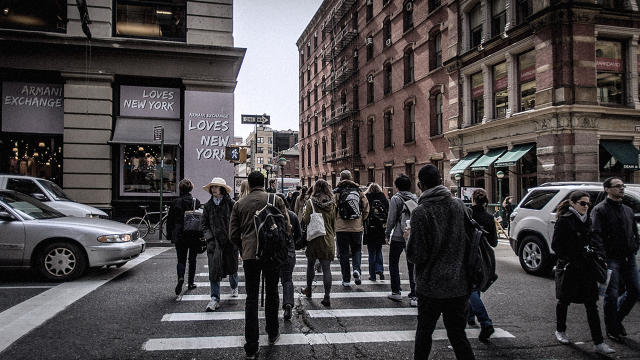
looking at crashes, you could filter the consequences (which exhibit up as dots on the map) by using injuries and fatalities, by using month and by using year, and via pedestrian, cyclist, or automobile incidents, offering an extremely unique have a look at the state of site visitors safety within the metropolis. A sliding timeline at the backside of the photograph lets you look at data for different months and years between 2009 and 2014. Clicking on the dots that signify crashes—orange for injuries, pink for fatalities—allows you to to see the collection of and type incidents at specific intersection. having a look at simply pedestrian injuries within the metropolis as an entire, the graphic becomes a kind of heat map for pedestrian threat zones. Downtown Brooklyn and midtown big apple convey up darkish orange for 2014, representing a larger density of pedestrian accidents for that year. but the map paints slightly of a dim image of pedestrian safety in the city over the years represented, especially at intersections with north-south working avenues in new york, which tend to be wider, one-approach streets with heavy site visitors compared to cross-town streets. however there are injuries in the entire boroughs, basically any place a lot of people walk—one reason town’s new default speed limit has been decreased to 25 mph, a pace at which site visitors crashes are a ways less prone to kill pedestrians or cyclists (an even slower pace restrict has turn out to be the adaptation for site visitors safety in Europe).
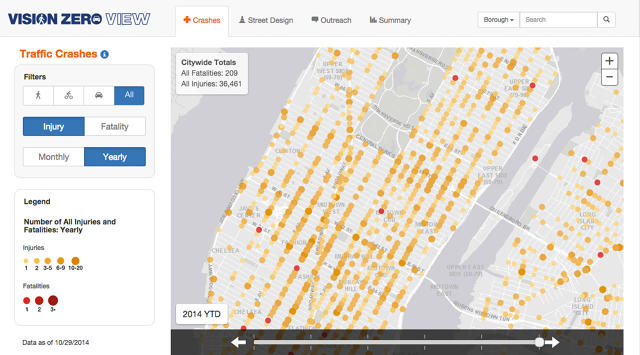
On a extra sure observe for town, the “boulevard design” tab means that you can explore what type initiatives the department of Transportation is endeavor as of October 29 of this year—streets which have transform arterial sluggish zones, areas which have develop into regional slow zones, web sites of main security projects, and the place prime pedestrian intervals had been introduced. (unluckily, which you could’t overlay the visitors fatality data on the road design map to see how the initiatives match up spatially.) according to Trottenberg, extra knowledge maps are forthcoming, although they’re now not ready to be released simply yet. “We pledged as a part of vision Zero to place out borough-broad safety plans,” she said. the town’s imaginative and prescient Zero public enter map—where the general public could record places the place there isn’t sufficient time to cross the street, negative visibility, failure to yield to pedestrians, speeding, and extra—yielded a whole lot of information for the department of Transportation to examine because it plans to revamp city streets. “We obtained 13,000 clicks on the web page,” Trottenberg mentioned. however there were discrepancies between what individuals said as risky and what the town’s knowledge presentations. “We basically heat mapped it,” Trottenberg said, looking at KSIs (Killed or seriously Injured, a metric of road security). “if you happen to take the maps of Brooklyn where folks clicked, and you in shape it with the warmth maps [of KSIs], it doesn’t suit.” people in prosperous neighborhoods were much more likely to use the website, but less affluent neighborhoods tended to have greater hotspots for fatalities, revealing a larger want for public outreach in those areas.
learn Full Story ![]() quick company
quick company
(202)

